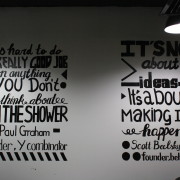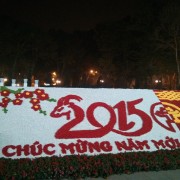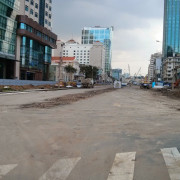Michelle Phan and Vietnam
“I am first a creator, but my ongoing objective is to leverage my personal success, to help mentor new and existing talent, and further help them achieve their goals.” —Michelle Phan
Michelle Phan is many things; an entrepreneur, a Vietnamese-American, a role model, a success story, and a phenomenon. Coming from humble beginnings, in 2007 she was rejected by Lancome for a makeup artist position because she had no prior sales experience. Instead, Phan turned to blogging and after two readers requested that she make a video tutorial, she obliged and a week later the video had 40,000 views. Today, Phan’s legacy so far is defined by $120 million in annual sales and 100 employees with brands like ipsy (offering a monthly makeup subscription) and her ICON Network (formerly “FAWN” or For All Women Network). Above all, Michelle Phan seems like she hasn’t reached her peak; just recently she was compared to and proclaimed as the next Oprah—all at the age of 27.
While Phan certainly hasn’t shied away from her roots, she also hasn’t seemed ready to take a plunge into business ventures in Vietnam. Phan’s first scheduled time in Vietnam was in November, 2010 (though she was not able to make it) and by her own account, the last (and first) time she visited Vietnam was in August, 2012. Recently, she celebrated her birthday in Japan, where she seems to prefer spending her time in Asia. However, she might be currently missing out on some very big opportunities in Vietnam.
[Update: Michelle Phan appeared at an event in Ho Chi Minh City on May 12, 2015.]
Investing in Vietnam would allow Phan to tap into one of the fastest growing markets (annual growth between 5 and 6 percent) in the world where Phan has clear and demonstrated cultural and heritage ties. Vietnam is part of the group dubbed “New Wealth Builders” which will outnumber mature markets after 2020. Already, the number of super rich (defined by having net worths over $30 million) in Vietnam has increased to over 100 in 2013 from only 34 in 2003. In short, many people are becoming successful as a result of the growing economy here and the growing middle class is continuously demanding newer and higher-quality products, fueled by their increased purchasing power.
Foray into Vietnam
Exactly how Phan should enter the market here is debatable. Vietnam is a complex market—each region (north, south, central, etc.) has its own quirks and consumer styles. However, there are over 90 million people, almost two-thirds of which are under the age of 40 and about a million babies are born here every year. The common area and interest is in two parts: foreign products are preferred in Vietnam, and young Vietnamese are already familiar with “vlogs” or video blogging—something that Phan pioneered in the US.
More importantly, Phan could be a role model for the country’s youth, especially its girls. In local advertising, White, Korean, or Japanese women are mainly present in ads—bombarding the youth with carefully crafted forms of “acceptable” beauty. But in Phan, young and impressionable Vietnamese women can see something else: themselves, i.e., someone who looks like them, who is successful, and who overcame a variety of challenges that they can directly relate to (gambling and/or absent father figure, sharing sleeping surfaces with siblings, financial troubles, rejection, etc.).
Phan’s makeup tutorials and other media can ultimately inspire and build confidence in young women. And in Vietnam that confidence can take several forms—both in the ability to do something (or try something new) but also to ask clarifying questions without the fear of looking foolish in front of colleagues (a significant problem in workplaces). And it can also provide something that money can’t buy: hope.
Cultural Trends
Even though KPOP, Korean soap operas, and other aspects of Korean culture have huge influence in today’s Vietnam, many young Vietnamese love American cultural products. American flag-themed fabrics can be seen in the streets of Ho Chi Minh City along with “Je t’aime Paris” apparel. Things are more toned down up north but in general, blonde-haired and blue-eyed people are often seen as the archetype of beauty and they are consistently showered with compliments when traversing the city streets in Vietnam.
For many Vietnamese, having white skin is one of their ultimate desires (meanwhile countless White people are trying to become a darker color via tanning—both naturally and artificially). There are entire product lines that are dedicated to skin whitening creams and bleaching lotions—a very different approach to beauty care than some westerners might be used to. In the streets, female motorbike drivers will go to great lengths by covering their entire bodies in order to prevent even a single ray of sunlight from reaching their skin (even in the blistering summer heat). There just aren’t many Vietnamese (role) models who are able to balance their local roots with international expectations (with the exception of some niche Viet Kieu singers) and transcend cultural boundaries.
Again, Phan is different; she is American and Vietnamese and she can help to bridge the cultural and understanding gap between people in both countries—imagine her appearing in a travel blog while going through Vietnam. It would help put Vietnam on the map for her legions of fans (whom she refers to as “Dreamers”). Right now the interest between the two countries is in one direction: toward the US for study (more than 16,000 Vietnamese students are currently studying in the US).
Additionally, Michelle, with her model/foreigner boyfriend would be a surefire hit in Vietnam. Husband and wife/DJ duo Matt (of Poreotics) “Dumbo” and Tessa Nguyen are an example of a cross-cultural couple who has found success in Vietnam (mostly based in Ho Chi Minh City). (They spin regularly at Ace Club in Ho Chi Minh City.)
A Rising Brand
As profiled in Forbes’ 30 Under 30 recently, “She’s also got a line of makeup at L’Oréal, a music venture that promotes artists on social media and a deal with reality-TV giant Endemol for an online lifestyle channel. ‘I feel like this is just the beginning,’ she says.” Indeed, Michelle Pham is just getting started: imagine the brand and licensing opportunities when she gets married, has a baby, and her firstborn goes to school for the first time, etc.
Her “name and fame” would allow her to take smart risks in Vietnam to extend her brand. In the future, the Icon Network could be the roadmap for young Vietnamese: lifestyle, personal interest, comedy, and other advice all intersecting together in unison. Some adventurous Vietnamese YouTubers have started to push boundaries here in cyberspace like An Nguy, DamTV, and Mie Nguyen, but a unifying platform (like Icon Network) does not yet exist.
(What’s the alternative? The most famous private television channel in Vietnam is scaling back its programming and some new experiments like Can Ho So 69 have been tried but have proven to be too risqué for mass consumption.)
Thus, Phan could make an impact here and leverage the Vietnamese diaspora in France, Australia, Eastern Europe, and so on. In other words, first establish a brand in Vietnam and then expand outward again, tapping into those existing networks between Vietnamese and Viet Kieu. An alternative is to form a following then expand into other areas such as fashion— and Vietnam already a has robust textiles and manufacturing industries. Michelle Phan already disrupted the cosmetics industry–what’s next for her?
Into Vietnam
Ipsy (or something like it) in Vietnam can find the right niche (via clever experimentation since most e-commerce here is COD). If not, then Birchbox, Loot Crate, Barkbox, or any other monthly subscription service (most likely after proving it can be done in China) will be the first to break into this and other emerging markets (already Bethany Mota has visited India, a one billion plus consumer market). That’s not to say that Michelle Phan hasn’t attempted to connect more deeply with Vietnam. Em, “a reflection of Me” is Phan’s attempt to mate her culture and her personal brand. “Em” meaning “she” or “her” in Vietnamese (and other things, depending on the context); but there’s no need to stop there—keep going until something beautiful happens.
So how exactly to build up in Vietnam?
- Start small: aptly translate YouTube videos for Vietnamese or release special videos for the Vietnamese market (which means videos 30 seconds to one minute in length—any longer and there’s not enough patience/attention span);
- Make more regular visits to Vietnam (and bring your boyfriend);
- Expand the Icon Network into Asia, especially Vietnam. There are a number of successful YouTube VJs here but you can also hand-select and cultivate suitable talent;
- Good quality and affordable makeup is hard to find in Vietnam; explore localization options for ipsy;
- Develop service learning, social enterprise, or impact investing opportunities—the dollar goes much further in Asia and being a good citizen is good marketing; and
- Mentor new and existing talent in Vietnam; there’s a lot of talent here. Young Vietnamese people are in the middle of changing times between tradition and modernity and feel like their generation is unlike any other. Start with the 2014 Graduate of the Year.









